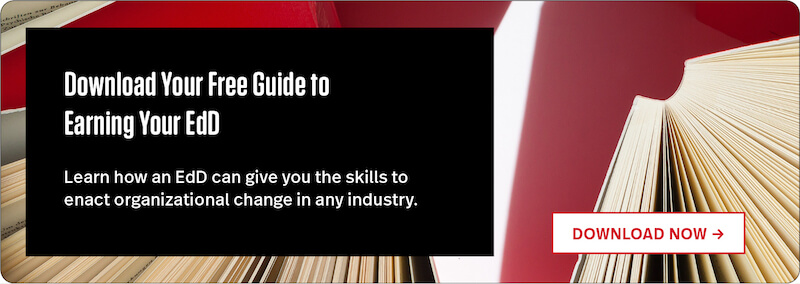You may not spot any schools while walking through downtown districts of major cities, but that doesn’t mean that all schools are tucked away in the suburbs. In fact, 30 percent of public school students and 43 percent of private school students go to class in urban areas each day.
“Kids all need the same skills and knowledge, but when we think more deeply about urban education, we’re diving in and thinking about what that context means for students,” says Sara Ewell, director of Northeastern’s Doctor of Education program and teaching professor in the Graduate School of Education.
Though each urban school has its own unique context, there is often overlap. Here’s what you need to know about urban education and how to best prepare for working within this space.
Download Our Free Guide to Earning Your EdD
Learn how an EdD can give you the skills to enact organizational change in any industry.
The Urban Classroom
As more families with the means to move out of cities take advantage of the opportunity to do so, the proportion of poor, non-white, and English language learning students has increased.
“Urban public school systems are, because of the United States’ history of segregation and racism, overwhelmingly attended by students of color from families of low socioeconomic status,” says Shaunna Harrington, associate teaching professor and faculty lead for Northeastern’s Master of Arts in Teaching program. “Low-income kids often have additional needs in the classroom.”
Those needs can include everything from support for children who have been exposed to violence to free or reduced meal programs for those who would otherwise go without breakfast and lunch. Chronic underfunding, however, has made it difficult for educators to meet these needs—and created a pervasive idea that urban schools are automatically “less than,” Ewell says.
“It’s approached with a deficit view, as if there’s something wrong with those kids, families, and teachers,” she continues. “When we use the term ‘urban education,’ we are actually just looking at the unique aspects in each of these contexts and what can we do to best meet learners in those spaces based on their needs.”
To best address those needs, educators need to focus on the factors that make urban education both rich and complex and how they can work in tandem with their communities to help students succeed.
Considerations of Urban Education
Familiarizing yourself with some of the unique aspects of urban education can help you better prepare for effective leadership within it. Some of the most important aspects to consider are the rich multiculturalism of urban schools, their often limited resources, and the likelihood that you’ll be working in an unfamiliar environment.
Great Diversity
In the 20 largest urban school districts in the U.S., an average 80 percent of students are non-white, according to the National Center for Education statistics, meaning urban classrooms are more likely to have a diverse mix of students.
“A high percentage of our educators are white, and a large percentage of them are female,” Ewell says. “In an urban classroom, you’re often dealing with multiple languages, cultural norms, and racial biases, so to meet the needs of each learner it’s important to acknowledge the diversity and use culturally relevant strategies in the classroom.”
Ewell notes that while respecting each student’s background and perspective is important no matter where schools are located, it can be particularly relevant in urban schools, where teachers and students often come from different backgrounds.
Limited Resources
During the COVID-19 pandemic, 43 percent of urban district leaders surveyed by Education Week said they could provide all students with online learning opportunities, and only 12 percent of urban teachers reported that families were picking up classwork in person—even though physical materials may be the only way children without reliable Internet connections can keep up with their studies.
“We need to be really aware of the inequities in the ways in which public education is structured in the United States,” Harrington says.
By keeping this front-of-mind, without slipping into the assumption that urban schools are worse than suburban or rural schools, teachers are better equipped to address the challenges of underfunding.
Navigating New Spaces
While many teachers who choose to work in urban schools have personal experience in similar environments, many find themselves adapting to a new one.
“We need to be really aware of our own social position in terms of understanding our own relationship to different types of privilege,” Harrington says.
This means taking the time to understand how your own experiences have shaped your perspective, and how the context of students’ lives—their families, neighborhoods, cultures, and communities as a whole—have impacted the way they approach education. Educators who understand and acknowledge any resulting differences may be better prepared to collaborate with the school community to effectively support students and meet their specific needs in the classroom.
Making an Impact in Urban Schools
Several strategies can help professionals make an impact on their students, and all continue the themes of collaboration, community, and attention that Ewell and Harrington emphasize in their own classrooms.
Check Your Mindset
Because urban schools are often characterized as struggling or deficient, educators must combat the idea that they are entering schools to save them. One way to accomplish this is to constantly seek out opportunities for collaboration and learning.
“It’s a reciprocal relationship where you’re bringing in the content expertise, but your community is bringing in the contextual expertise,” Ewell says. “Learn as much as you can about your students and families, and ask them what they need.”
Similarly, Harrington recommends paying attention to any unconscious biases you may find in yourself and how your own experiences have created your mindset.
“Shift into an assets-based perspective, and recognize the different assets that families and communities can bring,” she says.
Use Culturally Responsive Teaching
Ensuring that your teaching materials and curriculum reflect the varied backgrounds of students is another way to increase the likelihood of success in urban schools. According to multiple studies, representation really does matter—and a consistent lack of it could signal to students that they aren’t important.
Consider implementing culturally responsive teaching strategies, like reading stories about characters with similar backgrounds to your students and encouraging students to leverage their own experiences when it comes to making sense of information.
Culturally responsive teaching may also mean working with English language learners who don’t have the same grasp on the language as their peers.
“We have larger numbers of English language learners in our urban districts, though in Massachusetts that’s increasingly true across the state,” Harrington says. “Teachers should have the skills to appropriately adapt curriculum resources and instructional strategies to meet the needs of those students.”
The Northeastern Difference
Northeastern’s Doctor of Education (EdD) program is grounded in experience-based learning that encourages students to immerse themselves in urban school communities. Research typically entails holding on-site interviews, conducting field research, and other in-depth learning based in real classrooms around the world.
“Our courses are all built so that they have students going out into communities, even if they’re not in that student-teaching moment,” Ewell says.
In addition to this commitment to experience, Northeastern also highlights the importance of cultural understanding in teaching. Harrington notes that the state of Massachusetts has made it a priority to prepare and credential teachers who can work with culturally, linguistically, and economically diverse students, seamlessly supporting Northeastern in the university’s efforts to do the same.
“There’s a reflection, equity, and action framework that’s really threaded throughout all our coursework in a very intentional way,” she says.
Northeastern also offers the unique MacFarland Scholarship for new students who are working (or have the intention of working) as an educator in a public school at the elementary or secondary level within an urban area. These students are eligible to receive a scholarship award of up to $20,000 to help unburden them financially so they can go on to help make an impact in urban education.
Learn more about pursuing your Doctor of Education through Northeastern’s online and on-ground programs.







Related Articles
What is Learning Analytics & How Can it Be Used?
Reasons To Enroll in a Doctor of Education Program
Why I Chose to Pursue Learning Analytics